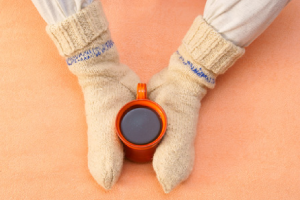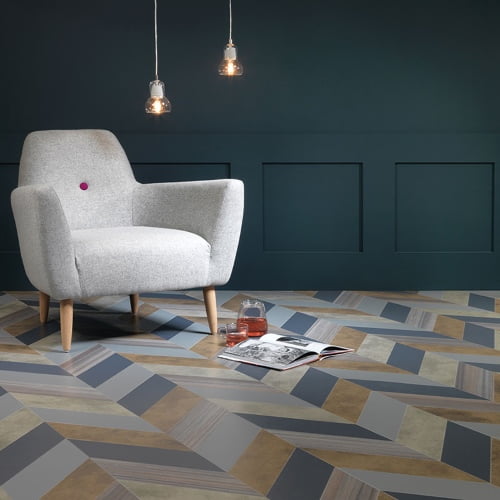Heated floors are best known for being used in bathrooms and kitchens, but heated flooring provides benefits for a variety of different tile installations. The properties of tile, marble, and stone floorings actually make underfloor heating systems more effective. Easy to install, economical to operate, and nearly maintenance free, heated flooring adds value to any tile installation and keeps energy bills lower and occupants happier.
In this article, we will discuss:
- The benefits of installing radiant heat under tile flooring.
- How to install a radiant heating system under a tile floor.
- How Warmup can help you design and purchase a radiant heating system for your home.
The Benefits of Utilizing Heated Flooring Under Tile
Heated floors under tile provide many benefits to the rooms where they are installed. Tile has two special properties that make it uniquely suited for use with underfloor heating systems: high thermal conductivity and high thermal capacity, which means that tile heats up quickly and retains heat well. Heating up quickly means the heating system can be more responsive and can be adjusted more easily. Retaining heat helps lower energy usage and make people feel more comfortable.
People generally feel hot or cold based on two things: the temperature of the air around them and the amount of heat radiating toward them. The Sun is a great example of heat that is radiated. Even when the air is cold, feeling the sunlight on your skin can warm you up. Using a radiant heating system under tile mimics that type of heating.
In a room with heated tile, the tile is able to radiate heat to anyone in the room. This creates a more even and comfortable feeling of warmth even when the air temperature is lower. When the entire tile floor has a radiant heating system, people feel more evenly warmed since the heat is radiated from all directions.
How to Install Heated Floors Under Tile
Not only are heated floors a great way to make any room more comfortable, they are also designed to be incredibly easy to install. Warmup offers 2 great solutions – DCM-PRO and StickyMat – to make underfloor heating installation simple and economical.

1. Measure the Room to be Tiled
Determine how much of the floor will be heated. Make a diagram of the room to ensure you have enough material. Don’t include permanent fixtures like vanities, toilets, showers, or tubs. The key is to determine how much floor area needs to be heated. As with most things, getting accurate measurements in this step can save you a ton of time later.
2. Acquire Materials and the Necessary Tools
Having all the needed materials and tools is essential to a smooth installation. Check that you have everything you need before beginning work:
- Undertile Heating Mats according to measurements
- Thermostat with floor sensor
- Digital multimeter
- Permanent marker
- Measuring tape
- Tape
- Scissors
To obtain a quick list of the materials recommended for your radiant floor heating project, check out this instant pricing tool from Warmup.
3. Test the Undertile Heating Mats
Before installation, check that the floor heating system is in good condition. Using a digital ohmmeter, measure the resistance of the heating wires. The resistance should be within 10% of the resistance listed on the tag or in the manual for that model.
4. Inspect and Clean the Subfloor
For a good installation, the subfloor needs to be clean and free of debris. Remove any nails or sharp objects that can damage the underfloor heating system. If the subfloor is concrete, adhere a cork or synthetic cork underlayment to the subfloor before installing the heating system. The cork helps ensure that the heat from the underfloor heating system makes its way to the tile and is not wasted heating the foundation.
5. Install the Undertile Heating Mats
One of the easiest steps is actually installing the underfloor heating mats. Unroll the mat across the subfloor using tape or hot glue to hold the mat in place. Cut the mesh as needed to fit into the space but be sure not to cut the heating element. To fit the mat around tricky obstructions like columns and toilets, cut the wire away from the mesh and free form the heating element to fit.

6. Position the Sensor
Once the system is completely laid out and installed, place the sensor for the thermostat. Ensure that the sensor goes between the heating elements and does not overlap them. Weave the sensor into the mesh or use hot glue to keep it from moving around. Good placement of the sensor will keep the thermostat working just like it should.
7. Test the System Once More
Now that all of the components are installed, check that everything is working properly before installing the tile. The ohmmeter should still read that the system’s resistance is within range. If not, fix the problem now while everything is still easily accessible.
8. Connect the Thermostat
The system is now ready to be connected to the thermostat. Be sure to adhere to all local requirements. It is recommended that a licensed electrician makes the connection to the thermostat. Since underfloor heating systems may require significant amperage during warm up and to prevent tripping the thermostat’s GFCI, it is recommended that the underfloor heating system be put on a dedicated circuit.
9. Install Tile with Modified or Unmodified Thinset
Once everything is connected and working properly, the tile flooring can be installed. Check with the tile manufacturer to make sure that the tiles are compatible with underfloor heating systems, but this is usually not an issue since most tiles will work great with these types of heating systems.
To begin the tile install, apply a layer of modified thinset over the heating elements and mesh and install the tile. Install the tile as normal including using mechanical systems to prevent lippage. When the thinset has cured and the flooring is stable, your underfloor heating system is ready for use.
Warmup Offers the Best Radiant Floor Heating Solutions to Install Beneath Tile
With Warmup, your tile floors will not be cold any more. Warmup’s easy to install system makes adding underfloor heating simple and economical to any tile installation. To get a quote and learn more about their underfloor heating systems, reach out to Warmup today.





![Thumbnail [200x250]](/wp-content/uploads/Indoor-Systems-Page-Image.png)
![Thumbnail [200x250]](/wp-content/uploads/image-13.png)
![Thumbnail [200x250]](/wp-content/uploads/Projects-Image.png)